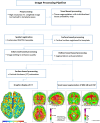Assessment of Brain Development in Children With Congenital Diaphragmatic Hernia - an Automated Brain Segmentation Approach
- PMID: 39740909
- PMCID: PMC11705146
- DOI: 10.21873/invivo.13828
Assessment of Brain Development in Children With Congenital Diaphragmatic Hernia - an Automated Brain Segmentation Approach
Abstract
Background/aim: Congenital diaphragmatic hernia (CDH) is a critical condition affecting newborns, which often results in long-term morbidities, including neurodevelopmental delays, which affect cognitive, motor, and behavioral functions. These delays are believed to stem from prenatal and postnatal factors, such as impaired lung development and chronic hypoxia, which disrupt normal brain growth. Understanding the underlying mechanisms of these neurodevelopmental impairments is crucial for improving prognosis and patient outcomes, particularly as advances in treatments like ECMO have increased survival rates but also pose additional risks for neurodevelopment. This study aimed to evaluate brain development in 2-year-old children who underwent CDH repair, with and without ECMO, compared to healthy controls using an MRI-based automated segmentation approach.
Patients and methods: The study included 31 children with CDH, of which 10 received ECMO therapy, and a control group of 31 healthy children. MRI-examinations were performed using a 3-T system. MRI data were processed using the CerebroMatic toolbox and SPM12 software to measure cerebrospinal fluid (CSF), gray matter (GM), white matter (WM), and cortical thickness (CT).
Results: Patients with CDH showed significantly increased volumes of CSF (p=0.009), GM (p=0.02), and total intracranial volume (TIV) (p=0.01), compared to healthy controls. ECMO-treated patients had significantly increased GM (p=0.01) and CSF (p=0.005) volumes in comparison to healthy controls. CT was significantly higher in CDH patients regardless of ECMO therapy, indicating potential maturational deficits.
Conclusion: The study reveals neurodevelopmental differences in children with CDH, particularly in those requiring ECMO therapy. Increased CT, GM, and CSF volumes suggest complex neurodevelopmental challenges.
Keywords: Congenital diaphragmatic hernia (CDH); brain segmentation; cerebrospinal fluid (CSF); cortical thickness; gray matter (GM); white matter (WM).
Copyright © 2025, International Institute of Anticancer Research (Dr. George J. Delinasios), All rights reserved.
Conflict of interest statement
The Authors declare no conflicts of interest in relation to this study.
Figures




Similar articles
-
Survival, intracranial lesions, and neurodevelopmental outcome in infants with congenital diaphragmatic hernia treated with extracorporeal membrane oxygenation.J Perinatol. 1999 Sep;19(6 Pt 1):436-40. doi: 10.1038/sj.jp.7200242. J Perinatol. 1999. PMID: 10685274
-
Survival and Neurodevelopmental Outcomes in Congenital Diaphragmatic Hernia Patients with Single versus Repeat Extracorporeal Membrane Oxygenation Runs.Am J Perinatol. 2024 May;41(S 01):e305-e311. doi: 10.1055/a-1877-9225. Epub 2022 Jun 16. Am J Perinatol. 2024. PMID: 35709727
-
Lung Perfusion MRI After Congenital Diaphragmatic Hernia Repair in 2-Year-Old Children With and Without Extracorporeal Membrane Oxygenation Therapy.AJR Am J Roentgenol. 2016 Jun;206(6):1315-20. doi: 10.2214/AJR.15.14860. Epub 2016 Mar 24. AJR Am J Roentgenol. 2016. PMID: 27010969
-
Extracorporeal membrane oxygenation in infants with congenital diaphragmatic hernia.Semin Perinatol. 2018 Mar;42(2):96-103. doi: 10.1053/j.semperi.2017.12.005. Epub 2018 Jan 12. Semin Perinatol. 2018. PMID: 29338874 Review.
-
ECMO in CDH: Is there a role?Semin Pediatr Surg. 2017 Jun;26(3):166-170. doi: 10.1053/j.sempedsurg.2017.04.006. Epub 2017 Apr 25. Semin Pediatr Surg. 2017. PMID: 28641755 Review.
References
-
- Emanuel H, Breitschopf HV, Harting MT, Martinez Castillo DJ, Yadav A, McBeth K, Hashmi SS, Ebanks AH, Harris TS, Lally KP, Jon CK, Stark JM, Mosquera RA. Pulmonary outcomes of congenital diaphragmatic hernia patients based on defect size (CDH Study Group Stage) Transl Pediatr. 2023;12(8):1490–1503. doi: 10.21037/tp-23-14. - DOI - PMC - PubMed
-
- Gerall CD, Stewart LA, Price J, Kabagambe S, Sferra SR, Schmaedick MJ, Hernan R, Khlevner J, Krishnan US, De A, Aspelund G, Duron VP. Long-term outcomes of congenital diaphragmatic hernia: A single institution experience. J Pediatr Surg. 2022;57(4):563–569. doi: 10.1016/j.jpedsurg.2021.06.007. - DOI - PubMed
MeSH terms
LinkOut - more resources
Full Text Sources
Medical
